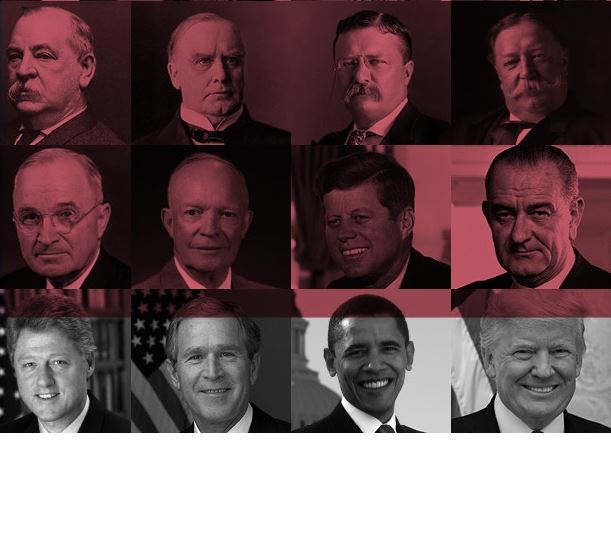Geen producten in je winkelmand.

- Dit event is voorbij.
Course on the political history of the United States
17/09/2020 @ 10:00 - 12:30
€179
A course in American history based on the development of the American political system.
On November 3rd 2020 it’s time for elections in the United States again. And of course Donald Trump will be reelected! Or not? Whether you are for or against this sitting and remarkable 45th President, it is certainly very interesting to understand why so many people think he will be reelected.
And that’s what we’re going to do – to understand what we’re dealing with, we’re going to look at American history through the lens of development of the American political system. It is a system that works better and fairer than that of most democracies elsewhere in the world, while at the same time it has some serious shortcomings. During six lectures, historian Dionijs de Hoog will take you through as many phases in American political history, those of the six ‘Party Systems’. Each of those six periods in America’s political history highlights a president, who was most typical for such a period. When we get to the here and now, you will know exactly how the electoral system in the United States works… ánd who will be the next American president.
The Course:
Lecture 1: President Thomas Jefferson and the First Party System, 1792-1824
Lecture 2: President Andrew Jackson and the Second Party System, 1828 – 1854
Lecture 3: President Abraham Lincoln and the Third Party System, 1854 – 1895
Lecture 4: President Woodrow Wilson and the Fourth Party System, 1896–1932
Lecture 5: President Franklin D. Roosevelt and the Fifth Party System, 1932-1968(?)
Lecture 6: President Ronald Reagan and the Sixth Party System, 1968-now
Please book this course at the bottom of the page.
This course consists – as an exception to the ten-lecture rule – of six lectures, which are given on Thursdays from 10 A.M. to 12:30 P.M. at the public library (OBA) on the Roelof Hartplein 430. The course starts on Thursday 17 September 2020 and ends on Thursday 29 October 2020. Due to the October Holiday there will be no lecture on Thursday 15 October.
With this lecture series you will receive a free digital overview after each class.
Please read the detailed explanation per lecture below.
Lecture 1: President Thomas Jefferson and the First Party System, 1792-1824
During this first lecture, the series will be introduced and we will discuss the “First Party System”. By that term we mean to refer to the period of the political party system that existed in the United States between 1792 and 1824. At that time, there was a struggle between two national parties for control of the presidency, Congress and the states. That struggle went on between the Federalist Party, primarily founded by Alexander Hamilton, and the rival Democratic-Republican Party, formed by Thomas Jefferson and James Madison, usually referred to as the Republican Party at the time. The Federalists were dominant until 1800, the Republicans after 1800. At that time there was a social order called the Jeffersonian Democracy, after one of the authors of the Declaration of Independence, the later President Thomas Jefferson.
Lecture 2: President Andrew Jackson and the Second Party System, 1828 – 1854
The Second Party System period ran from about 1828 to 1854 and was characterized by a rapid rise in the electorate’s interest in politics, starting in 1828. This was reflected in the high turnout at elections and meetings, the high demand for party newspapers, and a high degree of personal loyalty to parties. This period roughly coincides with what is called “the Jacksonian Era”, named after the seventh US President Andrew Jackson. Broadly speaking, the entire era was marked by Jackson’s political policies, after ending what he called a government “monopoly” by elites. Even before the Jacksonian Era began, suffrage had expanded to a majority of white male adult citizens, a result the Jacksonians were proud of. Jacksonian democracy also promoted the power of the presidency and the executive branch (the “executive” – still very important within the American political context) at the expense of the United States Congress, while at the same time seeking public participation, to promote the role of the government.
Lecture 3: President Abraham Lincoln and the Third Party System, 1854 – 1895
The Third Party System is the term used to denote the political period running from 1854 to the mid-1890s. It was dominated by the new Republican Party. Those Republicans did not miss an opportunity to emphasize that they were the ones who dragged the federal state out of the civil war alive, abolished slavery and gave the freedmen the right to vote. In addition, Republicans had simultaneously adopted many modernization programs, such as setting up national banks, building railways, and increasing social security spending. This period is characterized by sweeping developments where it comes to issues such as those of American nationalism, modernization in general and, of course, the ever hot topic “race”. Much of the American population viewed slavery as a backward threat to progress. At that time, it was the American President Abraham Lincoln who abolished slavery and thus set the United States on the path of progressive nation states.
Lecture 4: President Woodrow Wilson and the Fourth Party System, 1896–1932
The Fourth Party System refers to American political history from 1896 to 1932 that was dominated by the Republican Party, except for the 1912 – 1920 period during which Democrats were able to claim the White House for eight years. This period is also known as the Progressive Era. The central domestic issues concerned government regulation of railways and large companies (the ‘trusts’), where it came to trade the protective tariff was discussed, the role of unions, child labor, the need for a new banking system, corruption in party politics, primaries, the introduction of federal income tax, direct election of senators, racial segregation, efficiency in government, women’s suffrage and… wow!… immigration control. Foreign policy focused on the Spanish-American War of 1898, imperialism, the Mexican Revolution, World War I, and the creation of the League of Nations. That League of Nations, precursor to the United Nations, was created by President Woodrow Wilson, the same man who had previously sent the United States military to Europe to participate in World War I from 1917 onwards.
Lecture 5: President Franklin D. Roosevelt and the Fifth Party System, 1932-1968(?)
The Fifth Party System is the era of American national politics that began with the New Deal in 1932 under President Franklin D. Roosevelt. This era of Democratic Party dominance stemmed from the re-alignment of ‘voting blocks’ and ‘interest groups’ deemed crucial in US politics that supported the Democratic Party in the New Deal coalition after the Great Depression. For this reason it is often referred to as the “New Deal Party system”. That New Deal was actually a series of programs, government work projects, financial reforms, and regulations enacted by President Franklin D. Roosevelt in the United States between 1933 and 1936. All of which met the need for enlightenment, reform, and recovery after the Great Depression.
Lecture 6: President Ronald Reagan and the Sixth Party System, 1968-now
Opinions differ seriously about when exactly the Sixth Party System started, with data ranging from the 1960s to the 1990s. This lack of clarity is partly due to the fact that the Sixth Party System is characterized by an electoral shift from the situation as it was during the fifth party system of the New Deal: the Republican party became the dominant party in the south, in the countryside and in the suburbs; as the Democratic Party increasingly began to form a coalition of African Americans, Latinos and white urban progressives. In addition, there is a remarkable change in the political system in the Reagan era of the 1980s and beyond.
That president took American politics in a completely new direction. Father and son Bush seem to have taken the instructions of their teacher seriously, but Barack Obama was also president during the Reagan-influenced Sixth Party System. We will finish the series of lectures with a detailed analysis of the current presidency and I will make a prediction about what is to come. Because Donald Trump … is not to be underestimated!
